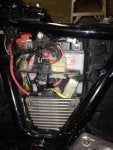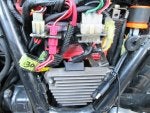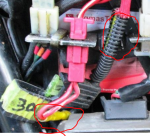85 Honda Shadow VT700
My battery needs replacement, and I think my head might explode from all the post I've read on here the past couple days. I know the factory battery is the "T"shaped 16A-AB 16AMP which is a lead/acid battery that requires maintenance. I also know that many members have switched to the AGM battery YTZ14S 12AMP, requiring no maitenance. Both battery type offer around 220CCA. I've gathered some of my questions that I'm still unclear about.
1) How much of a difference does the change in AMPs from the factory 16 AMP battery to the sealed 12 AMP make a difference in COLD weather starting on an 85 Honda Shadow? I've read that the older shadows require the 16 amps due to design. I would like a battery that is reliable all year round. I do have a tender, and am willing to use it frequently.
2) Would this version of the YTZ14S work? it seems to be a rugged battery, but again, with only 12 AMPs. https://www.batteriesplus.com/productdetails/cylaz14sxta
3) I was also looking at this OEM replacement. https://www.batteriesplus.com/productdetails/cyl16aabxt
I'm less concerned with the price difference and care more about which battery will be more reliable year-round. My biggest conern is in regards to the AMP difference in the batteries. I don't want to buy the YTZ14s and still have issues in the winter due to the lower AMPs. Any help/suggestions will be appreciated!
-James
My battery needs replacement, and I think my head might explode from all the post I've read on here the past couple days. I know the factory battery is the "T"shaped 16A-AB 16AMP which is a lead/acid battery that requires maintenance. I also know that many members have switched to the AGM battery YTZ14S 12AMP, requiring no maitenance. Both battery type offer around 220CCA. I've gathered some of my questions that I'm still unclear about.
1) How much of a difference does the change in AMPs from the factory 16 AMP battery to the sealed 12 AMP make a difference in COLD weather starting on an 85 Honda Shadow? I've read that the older shadows require the 16 amps due to design. I would like a battery that is reliable all year round. I do have a tender, and am willing to use it frequently.
2) Would this version of the YTZ14S work? it seems to be a rugged battery, but again, with only 12 AMPs. https://www.batteriesplus.com/productdetails/cylaz14sxta
3) I was also looking at this OEM replacement. https://www.batteriesplus.com/productdetails/cyl16aabxt
I'm less concerned with the price difference and care more about which battery will be more reliable year-round. My biggest conern is in regards to the AMP difference in the batteries. I don't want to buy the YTZ14s and still have issues in the winter due to the lower AMPs. Any help/suggestions will be appreciated!
-James













